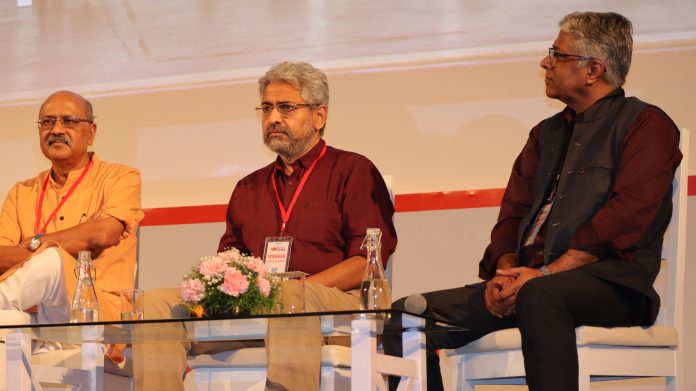
Perhaps programmed for a bit of calling out, the panelists at the ‘Calling Out Our Own’ session at Media Rumble tended to be mostly sedate but they all grumbled about the title of the session. Moderated by Abhinandan Sekhri of News Laundry, the panel included Sevanti Ninan, media columnist, founder and longtime caretaker of the media watchdog website www.hoot.org; Shekhar Gupta, former caretaker executive and chief editor of The
Indian Express and currently founder of the digital platform The Print; Siddharth Varadarajan, former editor of The Hindu and the founder editor thewire.in; and R Jagannathan, a veteran journalist and editor who has been the editor of the monthly print
and online magazine Swarajaya for the past four years.
Ninan lamented the lack of funding of The Hoot website over the years since it was started in 2001, which has meant that now it only functions as an archive of its past articles hosted by Ashoka University and has given up its active media watch role. Gupta took the opportunity to rant against the title of the session. His rant against the sponsorship of the Media Rumble by Facebook was actually quite fair and acknowledged by the moderator,
who is also one of the organizers of the event. Gupta said, broadly, “Not only is every media conference in the world today sponsored by Facebook and the FAGA (Facebook, Apple, Google, Amazon) cohort, but unlike most of them the opening talk or conversation doesn’t stoop to begin with Facebook.” (With due respect to Gupta, I personally think that the organizers may have thought it was best to get the main sponsor out of the way at jump street – since who arrives on time for the first session of a rumble?)
Moreover, Gupta made an unchallenged case for better media coverage by the mainstream media. Calling himself and the other male panelists refugees from mainstream media, he grumbled about the lack of skill and depth in writing about the media. Of course, he contradicted himself when he said The Indian Express (when he was doing double duty as its executive head and editor) had been roasted by then Hindustan Times’ journalist Shuchi
Bansal. After evaluating that she had her facts right and had dotted her i’s, he congratulated himself for immediately hiring her as The Indian Express’ media correspondent. (Shuchi Bansal is currently Mint’s media, marketing and advertising
editor.)

Varadarajan, who denied being a refugee (at least from the mainstream media), said that when he worked for Bennett-Coleman, criticism of other media was considered a sensitive topic that required the official intercession of the ‘4th floor.’ However, while he was at The Hindu, the policy was somewhat liberal in its coverage and critique of media, although
there was perhaps an unwritten gentlemanliness about the subject. In his tenure as the paper’s first professional non-family chief editor, considering the media as a fit subject
deserving in-depth coverage, he hired and empowered a media correspondent.
To his credit, Varadarajan acknowledged that media analysis and critique is very much alive in India, mentioning the video stings by Cobra Post of 25 news organizations in 2018, in which several advertising professionals and newspaper owners were essentially caught on video with their pants down – pandering to the government for a piece of its forthcoming general election advertising spend. He also mentioned the well-known cowardice of the Bennett-Coleman group in removing stories from its website about current
home minister Amit Shah’s son Jay Shah’s sudden exponential increase in wealth based on government documents.
At the Media Rumble session, Varadarajan modestly neglected mention of the harassment by the Shahs of www.thewire.in in the Gujarat courts and that the news platform stood up to this by fighting it in the Gujarat courts. Thewire.in (a four-year old news platform on the web) by going to court has contributed to the necessary and further establishment of the constitutional right to freedom of expression and the right to publish. At the same time, some of the biggest mainstream print media marginalized the story itself and quickly gave up the coverage of the court case in which the Shahs were ultimately defeated when the
civil court in Mirzapur, Ahmedabad vacated the ex parte ad interim injunction imposed on The Wire.
Since the non-discussion grumble actually ended with a mutual love-in brokered by the lovable Sekhri, it is unfortunate that the session did not wholeheartedly acknowledge that the media does in fact cover the media and that much can be improved and this cannot necessarily be a daily mainstream coverage. Perhaps the coverage is sporadic, but then
how well and consistently does the mainstream media cover science, agriculture, poverty, sanitation, education or public health? Media too is a specialized subject and business and perhaps not all issues concerning it go beyond the interests of the investors and professionals involved.
Media self critique
Moreover, how can one deny that the India media has generally inspired informed and critical writing about itself and that it is increasingly self-conscious and self-critical? Although a couple of the panelists mentioned The Mint, they did not acknowledge the critical tradition which includes Debonair magazine’s four articles about wellknown
newspaper editors titled ‘The Windbags of India’ in the previous century. Ninan’s media columnship over years was mentioned only as an exception. Recent books by journalists have also taken up substantive issues of content and style in television news media.
Neither were the writings of Vanita Kohli Khandekar in the Business Standard discussed, nor Robin Jeffrey’s well-researched series of articles in the Economic and Political Weekly in the 1990s about the Indian news media publishing houses that were serially published
both in Indian Printer and Publisher and as a book. The recent critical examinations of the Indian media by Caravan and even its long read about Shekhar Gupta went un-noted.
The mainstream coverage of the Indian women journalists’ ‘Me Too’ movement, which has so far led to the resignation of a publisher and minister in the government, also went unacknowledged.
In a country where journalists hanker for ambassadorships and nominations to the upper house of parliament and where a considerable number of media houses are owned or financed by politicians and government advertising, self-critical journalism is naturally a specialty – needing to be both factual and tactful. These are constraints but requiring no more a compromise than ethical journalists everywhere have to struggle with. Indian
journalists and publishers as a whole are no better or worse than in any other country where the front pages are filled with ‘official’ numbers from the battlefield or where journalists are embedded in foreign wars for regime change.
As one of the panelists at the Media Rumble session said, maybe the editors are too scared to criticize those who are their prospective employers. However, to paraphrase AJ Liebling, the day has dawned when the freedom of the press no longer belongs to those who own
one. As was pointed out in another session, print and online media are subject to the same constitutional freedoms and, increasingly, refugees or not from the mainstream print
media, as journalists and editors become stakeholders of their own platforms, they risk their hard-won and tenuous credibility unless they speak out about their own quality,
constraints and rights.

















